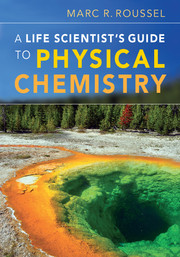Book contents
- Frontmatter
- Contents
- Preface
- 1 Orientation: what is physical chemistry about?
- Part One Quantum mechanics and spectroscopy
- Part Two Thermodynamics
- 4 Thermodynamics preliminaries
- 5 The First Law of Thermodynamics
- 6 The Second Law of Thermodynamics
- 7 Free energy
- 8 Chemical equilibrium and coupled reactions
- 9 Non-ideal behavior
- 10 Electrochemistry
- Part Three Kinetics
- Appendix A Standard thermodynamic properties at 298.15 K and 1 bar
- Appendix B Standard reduction potentials at 298.15 K and 1 bar
- Appendix C Physical properties of water
- Appendix D The SI system of units
- Appendix E Universal constants and conversion factors
- Appendix F Periodic table of the elements, with molar masses
- Appendix G Selected isotopic masses and abundances
- Appendix H Properties of exponentials and logarithmic functions
- Appendix I Review of integral calculus
- Appendix J End-of-term review problems
- Appendix K Answers to exercises
- Index
8 - Chemical equilibrium and coupled reactions
from Part Two - Thermodynamics
Published online by Cambridge University Press: 05 June 2012
- Frontmatter
- Contents
- Preface
- 1 Orientation: what is physical chemistry about?
- Part One Quantum mechanics and spectroscopy
- Part Two Thermodynamics
- 4 Thermodynamics preliminaries
- 5 The First Law of Thermodynamics
- 6 The Second Law of Thermodynamics
- 7 Free energy
- 8 Chemical equilibrium and coupled reactions
- 9 Non-ideal behavior
- 10 Electrochemistry
- Part Three Kinetics
- Appendix A Standard thermodynamic properties at 298.15 K and 1 bar
- Appendix B Standard reduction potentials at 298.15 K and 1 bar
- Appendix C Physical properties of water
- Appendix D The SI system of units
- Appendix E Universal constants and conversion factors
- Appendix F Periodic table of the elements, with molar masses
- Appendix G Selected isotopic masses and abundances
- Appendix H Properties of exponentials and logarithmic functions
- Appendix I Review of integral calculus
- Appendix J End-of-term review problems
- Appendix K Answers to exercises
- Index
Summary
Life is a far-from-equilibrium phenomenon, so one might reasonably question the utility of equilibrium theory to biochemists. There are a few reasons why you should care about equilibrium. One is that we still do a lot of experiments in test tubes, and under those conditions, systems eventually go to equilibrium. Another reason is that some reactions, like acid–base reactions, equilibrate much faster than others, so they can be treated as being in equilibrium. There is another, more subtle reason: we saw earlier that reversible processes, those in which the system is constantly in equilibrium, are the most efficient ones possible. Equilibrium therefore sets a limit to the efficiency of chemical processes, an idea we will use when we discuss how one reaction can drive another forward.
What does ΔrGm mean?
The molar free energy of reaction, ΔrGm (as well as other Δ quantities in thermodynamics), is a funny quantity. We typically think of it as the difference in free energy between reactants and products, since that's how we calculate it. However, its meaning is a bit more subtle than that. To make things specific, imagine that we have a reaction
reactants → P + some other products
in a system held at constant temperature and pressure. ΔrGm represents the change in free energy when we convert one molar equivalent of reactants to one mole of P under specified conditions (concentrations, pressures etc.). In other words, the composition of the system should not change as our mole of P is made. However, if we carry out this conversion, we will change the quantities of reactants and products, and thus the composition.
- Type
- Chapter
- Information
- A Life Scientist's Guide to Physical Chemistry , pp. 157 - 184Publisher: Cambridge University PressPrint publication year: 2012



